L13 - Open Wounds
1/16
There's no tags or description
Looks like no tags are added yet.
Name | Mastery | Learn | Test | Matching | Spaced |
|---|
No study sessions yet.
17 Terms
Soft tissue
Includes the layers of the skin, fat and muscle
List the three layers of skin
Epidermis: provides a barrier to bacteria another organisms that can cause infection
Dermis: contains nerves, sweat glands, oil glands and blood vessels
Hypodermis: (subcutaneous layer): located beneath the epidermis and dermis, and contains adipose (fat), blood vessels, and connective tissue
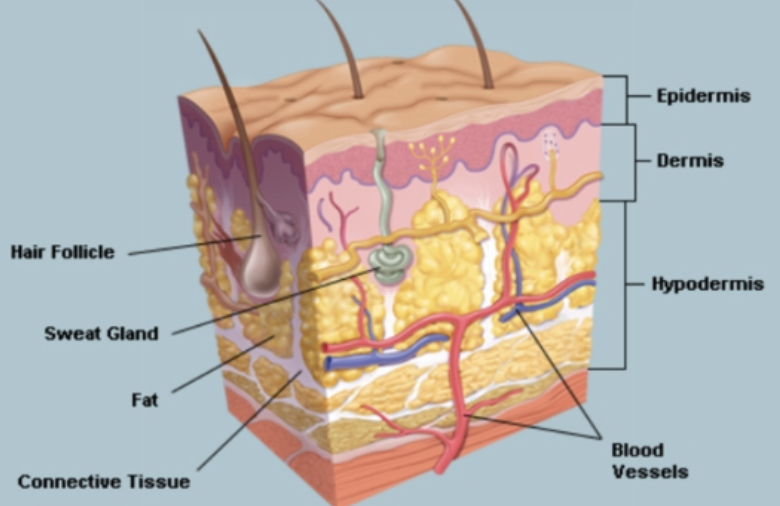
Wound
A physical injury involving the soft tissue
Describe the difference between a closed and open wound
Closed wound
Has no superficial tissue damage
Simplest closed wound is a “bruise” also called a “contusion”
Open wound
An open wound has a break in the surface of the skin
Infection is a primary concern with open wounds
Signs and Symptoms of shock due to internal bleeding
Skin that feels cool and looks pale or bluish
An altered level of consciousness
A rapid, weak heartbeat
Excessive thirst
Tender, swollen or rigid areas of the body, such as the abdomen
Bruising over the injured area
Rapid breathing
Vomiting blood or coughing up blood
An injured extremity that is blue or extremely pale, swollen, and rigid
Care for Closed Wounds (if minor)
If minor, apply ice to the injured area
Make a cold pack by filling a sealable plastic bag with a mixture of water and ice, and apply it to the injured area for about 20 minutes. If an ice and water mixture is not available, use a bag of frozen vegetables or a chemical cold pack as an alternative. Do not place a chemical cold pack directly on the bare skin- it can burn it. Place a thin towel as a barrier between the cold pack and the bare skin.
Remove the cold pack and wait 20 minutes before reapplying a new cold pack
If the person is not able to tolerate a 20 minute application limit application to 10 minutes
Elevating the injured part may help to reduce swelling; however, do not elevate the injured part if doing so causes more pain or you suspect a dislocation or fracture
Care for Closed Wounds (if severe)
Call 9-1-1 and treat for shock
A person complains of severe pain or cannot move a body without pain
You think the fourth that caused the injury was great enough to cause serious damage
An injured extremity is blue or extremely pale
The persons abdomen is tender and distended
The person is being blood or coughing up blood
The person shows signs and symptoms of shock or becomes confused, drowsy, or unresponsive
List six main types of open wounds
Abrasion
Laceration
Avulsion
Amputation
Puncture
Crush wound
List the care for all types of open wounds
A major open wound may have severe bleeding, deep or extensive destruction of tissue, or a deeply embedded or impaled object
Call 9-1-1
Put on gloves
Control for any severe external bleeding first
Cover the open wound with a sterile non-stick pad to lessen the chances of infection (covering the wound helps so the victim doesn’t have to look at it, lessening psychogenic shock)
Be prepare to treat for shock
List the signs and symptoms of an infected wound
Increased pain, swelling, redness or warmth and the area around the wound
Red streaks extending from the area around the wound
Pus (a thick yellow or green fluid) draining from the wound
Fever
Describe how to prevent infection in an open wound
Dressings: pads placed directly on the wound to absorb blood and other fluids and prevent infection
Commonly ranging from 2 to 4 inches square
Bandage: any material that is used to wrap or cover any part of the body → used to hold dressings in place, to apply pressure to control bleeding, to protect a wound from dirt and infection, and to provide support to an injured limb or body part
Pressure bandage: Any bandage applied snugly to create pressure on a wound or an injury
Roller bandage (or roller gauze) is usually made of gauze or gauze-like material
Abrasion
Most common type of open wound
Characterized by skin that has been rubbed or scraped away, such as often occurs when a child falls and scrapes their hands or knees on a rough surface road
Care for an Abrasion
Put on gloves
Since there is very little bleeding, there is no need for direct pressure
Wash the wound thoroughly with regular soap and water and gently scrub the area to remove any dirt, small rocks, or debris that is caught in the wound. * Note: this hurts! A lot. But it is the most important part. Any debris left in the wound can lead to infection later, so make sure to clean the wound thoroughly
Dry the wound with clean, sterile gauze
Cover the wound with a layer of antibiotic ointment (neosporin, triple antibiotic, bacitracin, polysporin) as long as there are no known allergies (some people are allergic to antibiotic ointment)
Cover the wound with a non-stick, sterile dressing and secure. (a bandaid works if it is big enough, but sometimes abrasions can be large, think "turf burn")
Wash your hands
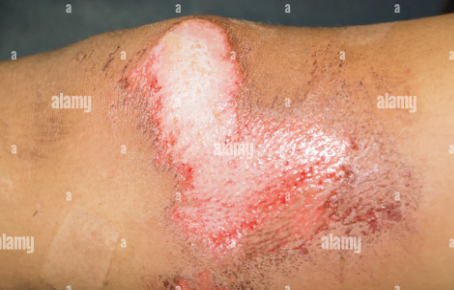
Laceration
A cut which may have either jagged or smooth edges
Lacerations usually bleed freely and, depending on the structures involved, can bleed heavily
Lacerations are not always painful because damaged nerves cannot transmit pain signals to the brain
Lacerations can easily become infected if not cared for properly
Care for a laceration depends on the extent of the cut
Control for any bleeding
Cover the wound
Refer to the doctor
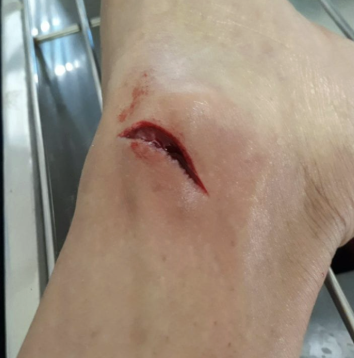
Avulsion
Serious injury in which a portion of the skin and sometimes other soft tissue is partially or completely torn away
A partially avulsed piece of skin may remain attached but hangs like a flap
Bleeding is usually significant because of avulsions often involve deeper soft tissue layers.
Care for an Avulsion
The primary concern for a first aider should be minimizing the risk of infection while the victim is transported to the hospital
Cover the avulsed tissue with a sterile, non-stick pad and cover with spiral gauze, paying careful attention to securing the gauze, but not applying unnecessary pressure over the wound (don't wrap tightly like you would for a severe bleed)
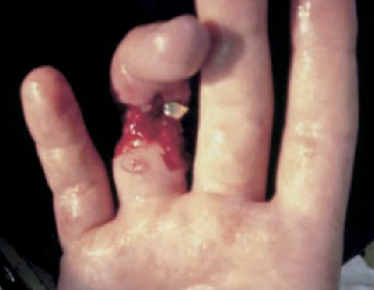
Amputation
Although damage to the tissue is severe when a body part is severed, bleeding may not be as bad as you might expect
Care for Amputation
Call 9-1-1.
Put on disposable gloves.
Provide care for the open wound as described in "specific care for major open wounds".
Wrap the severed body part in sterile gauze or any clean material, such as a washcloth. Moisten the cloth with sterile saline (if available), if not use dry sterile gauze as shown in the picture below.
Place the wrapped part in a sealable plastic bag or container. Label it with the persons name and time and date it was placed in the bag
Keep the bag cool by placing it in a larger bag or container of ice- not on ice alone and not on dry ice
Make sure the bag or container is transported to the medical facility by EMS personnel with the injured person
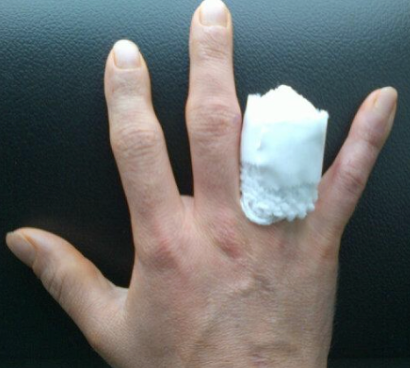
Puncture
Results when the skin is pierced with a pointed object, such as a nail, a piece of glass, a splinter or a knife, gunshot
Because the skin usually closes around the penetrating object, external bleeding is generally not severe
Internal bleeding can be severe if the penetrating object damages major blood vessels or internal organs
Embedded object: object that remains in the wound
Care for Puncture Wounds
Call 9-1-1
Cover the open wounds with sterile non-stick pads and refer

Crush Wound
A crush injury is the result of a body part, usually and extremity, being subjected to a high degree of pressure, in most cases after being compressed between two heavy objects
This type of injury may result in serious damage to underlying tissues and cause bleeding, bruising, fracture, laceration, and compartment syndrome, which is swelling and an increase in pressure within a limited space that presses on and compromises blood vessels, nerves and tendons that run through that space
In severe crush injuries to the torso, internal organs may rupture.
Crush injuries can be open or closed.
Care for Amputation
Crush Injury
Call 9-1-1 and cover the wound with a sterile, non-stick dressing